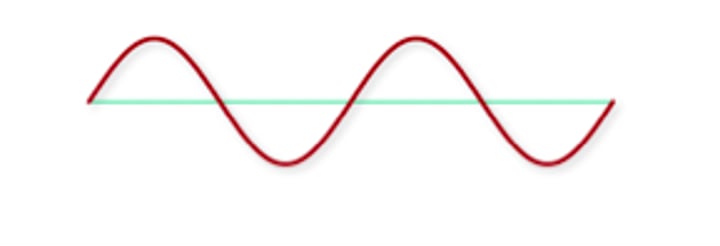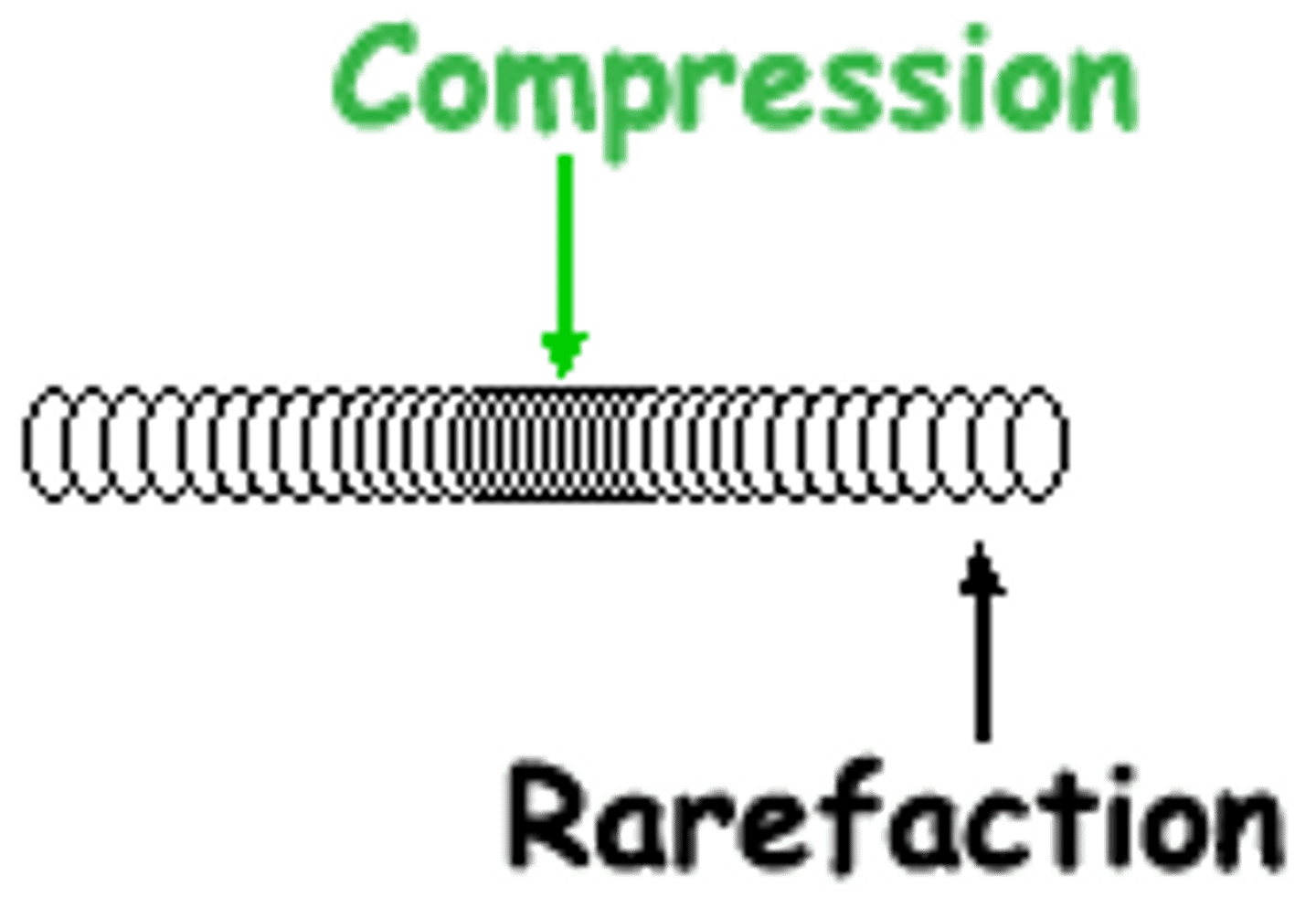iGCSE Edexcel Physics Waves
1/64
There's no tags or description
Looks like no tags are added yet.
Name | Mastery | Learn | Test | Matching | Spaced |
|---|
No study sessions yet.
65 Terms
wave
a disturbance which travels through media caused by oscillations/vibrations

oscillation/vibration
when an object moves back and forth repeatedly, on either side of some fixed position

what are the types of waves?
longitudinal and transverse

longitudinal waves
oscillations occur parallel to direction in which the energy or wave is moving

all waves transfer ______ and ___________ without transferring ______
energy, information, matter

examples of longtitudinal waves
-sound waves
-pressure waves
-P-waves

compression
where the points are close together

rarefactions
where the points are spaced apart

transverse waves
oscillations at right angles (90º)/perpendicular to direction in which the energy or wave is moving

examples of transverse waves
-electromagnetic waves
-vibrations in a guitar string
-s-waves
-ripples on the surface of water

trough
the point on the wave that is the lowest below the rest position

peak/crest
the point on the wave that is the highest above the rest position

displacement
the distanced moved from the rest position

amplitude
the maximum displacement moved from rest position

time period
the time taken for a single wave to pass a point

wavelength
the distance between corresponding points in the wave from one crest to the next crest

frequency
the number of waves passing a point in a second

wavefront
useful way of picturing waves from above

state the formula linking frequency and time period
frequency, f (in hertz) = 1 ÷ time period, T (in seconds)

state the formula linking average speed, distance and time
average speed (m/s) = total distance travelled (m) ÷ time taken (s)
state the formula for wave speed
wave speed, v (in m/s) = wavelength (in m) * frequency, f (in Hz)

electromagnetic waves
transverse waves that transfer energy from the source of the waves to an absorber
radiation
any form of energy originating from a source
the electromagnetic spectrum from lower energy to higher energy
-radiowaves
-microwaves
-infrared
-visible light
-ultravioler
-x-rays
-gamma rays

visible light
the range of wavelengths which are visible to humans

similarities of em waves
-transfer energy but not matter
-transverse waves made up of electric and magnetic fields
-travel at the same speed, in a given medium

differences of em waves
-amount of enrrgy transferred is not the same
-have different wavelengths and frequencies
-energy transferred depends on their wave length

colours from lowest to highest energy
red, orange, yellow, green, blue, indigo, violet

uses of radio waves
communications

uses of microwaves
cooking and satellite communications

uses of infrared
-remote controls
-night vision
-fibre optic communications
-infrared cameras
-heating/cooking things

uses of visible light
fibre optic communications and photography

uses of ultraviolet
energy efficient lamps, sun tanning

uses of x-rays
x-ray images

uses of gamma rays
sterilising food and medical equipment
detection of cancer and its treatment

which EM waves are ionising?
ultraviolet, x-rays, gamma rays

dangers of radio waves
none

dangers of microwaves
internal heating of body tissue

dangers of infrared
skin burns

dangers of visible light
-eye damage
-sunburn
-skin cancer

dangers of uv
-eye damage
-sunburn
-skin cancer

dangers of x-rays
kills cells, mutations, cancer

dangers of gamma rays
kills cells, mutations, cancer

spectrum of colours
the dispersion of colours when visible light refracts

wave reflection
a wave hits a boundary between 2 media and does not pass through, but instead stays in the original medium

angle of incidence (i)
the angle of the wave approaching the boundary

angle of reflection (r)
the angle of the wave leaving the boundary

law of reflection
reflected angle = incident angle

reflection from plane mirror
-the image is the same size as the object
-the image is laterally inverted
-the image is virtual and upright
-it is as far behind the mirror as the object is in front
echolocation
the use of reflected sound waves to determine distances or to locate objects
refraction
a wave passes a boundary between 2 different transparent media and undergoes a change in direction
TAGAGA
Towards (to normal)
Air
Glass
Away (from normal) Glass
Air
refractive index
a measure of the speed of light through the substance compared with the speed of light in a vacuum; the ratio between sin(i) and sin(r)

formula for refractive index
n = sin(i)/sin(r)

critical angle
when the angle of refraction is exactly 90º and is refracted along the boundary

TIR
when waves travel from a more optically dense medium to a less optically dense medium and the angle of incidence is greater than the critical angle

examples of TIR
-bicycle and car reflectors
-binoculars
-the prismatic periscope
-optical fibres
-the endoscope

formula for critical angle
n = 1/sin(c)

speed of sound in solids, liquids, gases
1. solid - fastest
2. liquid - medium speed
3. gas - slowest

audio frequencies
the range of frequencies that the human ear can detect

amplitude of sound wave
the loudness of the wave

high pitch
high wave frequency

low pitch
low wave frequency

refraction of sound waves
sound waves are refracted when parts of a wave front travel at different speed which is based upon temperature. wave will travel faster in warmer air than cooler air

the doppler effect
apparent change in frequency, which occurs when a source of waves is moving and is a property of all waves
